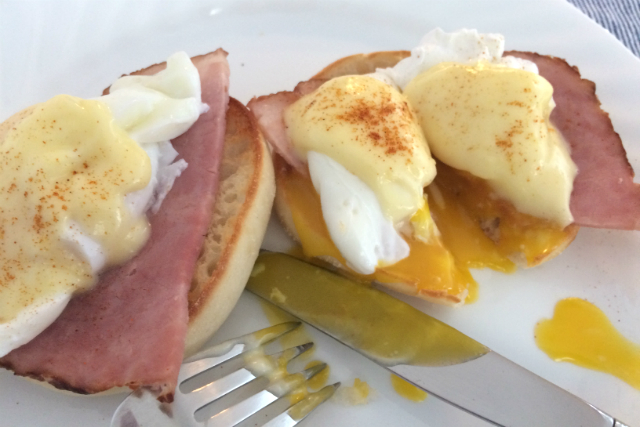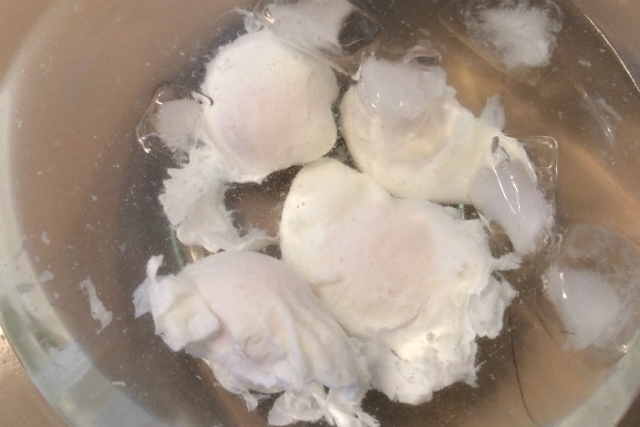Eggs Benedict Brunch Adventure
Going out to brunch is one of the nicest treats I know. If eggs Benedict are on the menu — or in the buffet line — chances are that I’m going to make a beeline for a serving. It’s so decadent. So delicious. With so much fat, it’s kind of naughty, too.
And, like many brunch-goers before me probably buzzed from one too many mimosas, I thought, “Hey I should be able to make this at home.” Fast forward to me madly stirring a bowl of scrambled Hollandaise. The sauce was broken and, in all honestly, I cracked a little, too.
Since that maddening day, I was determined to figure out how to avoid those mistakes and succeed in making eggs Benedict for us with decent homemade Hollandaise. Once I even used leftover smoked salmon and avocado slices in place of the ham — a nod to one from the Hotel Boulderado’s Spruce.
Figuring out eggs Benedict just for two was tricky. Most recipes serve at least four. Some are for a crowd. I wanted to make foolproof Hollandaise with an immersion blender, but didn’t want leftovers that couldn’t be saved. The recipe below is a bit of work, yes, but very much worth it for a special brunch for two at home.
Feel free to replace the ham with something else entirely like avocados, smoked salmon, tomato slices, roasted asparagus. Go ahead and get fancy. Pour some orange juice into wine glasses. You can totally do this.
Eggs Benedict Brunch for Two
Eggs:
4 Fresh eggs, rinsed and dried
Vegetable oil spray
White vinegar
Hollandaise:
1 Large egg yolk (from a fresh egg)
½ Tbsp. lemon juice
½ Tbsp. water
4 Tbsp. unsalted butter cut into chunks
Salt
White pepper or freshly ground black pepper
To serve:
2 plain English muffins, preferably Bays
4 hickory-smoked cooked ham slices or an alternative of your choice
Paprika
Butter (optional)
Note: It helps to have all the kitchen tools and ingredients ready before starting on this adventure.
Fill a medium-sized glass bowl with cold water and several ice cubes, set aside. Preheat the oven to 450°F. Put a piece of aluminum foil, dull side up, on a baking sheet and set that aside.
Spray a large-sized saucepan with vegetable oil before filling it most of the way with tap water. Add a couple tablespoons of white vinegar. (Or not, if you follow the Alice Medrich school of thought.) Bring water to a boil and then reduce heat to medium-low. Wait until bubbles are forming but not breaking.
Poach the eggs: Crack one egg into a small bowl. Gently roll the egg into the hot water. Repeat with the remaining eggs. If they sink you can gently loosen them from the bottom with a nonstick spatula. I remove the egg white tails later, but if you’d like to strain each egg momentarily before adding them to the hot water, that works.
Cook 3½ minutes or until the white has just turned completely opaque. After a couple of minutes, you can gently nudge them with a plastic spoon or nonstick spatula to get a sense of their consistency. Keep them in if you’re seeing translucent uncooked white.
Remove the eggs one at a time with a slotted spoon, transferring them to the bowl of ice water. At this point you can carefully snip off the tails with scissors or just avoid pulling them along into the cold water. Wash the spoon and the saucepan. Fill the pan with warm salted water (as if for pasta) and set it on a cold back burner.
Messy, yes. But trust me they will be delicious.
Hollandaise: Have a small glass bowl and spatula ready. Set up a double boiler using your smallest saucepan and a glass bowl that fits in it. (It helps to have another clean bowl the same size, although you can clean the original for the last step.) Put enough water in the pan so it doesn’t touch the bottom of the glass bowl. Bring to a boil and then reduce to a bare simmer.
Whisk the egg yolk, lemon, and water together constantly in the glass bowl over the double boiler until thick. You can keep pulling the whole thing off the heat periodically to avoid cooking the yolk. Once thick, turn off the heat, pull the double boiler completely off the heat, and whisk the butter pieces in one by one. Add salt and pepper to taste and immediately transfer the sauce to the clean, cool bowl using the spatula. Set the whisk aside for later. Now you can take a breather.
To serve: Put the English muffins, cut side up, on the baking sheet. Bake in the oven on the middle rack for 4 minutes or until edges are golden. Bring the pan of salted water to a boil and reduce to a simmer. Bring the water in the small double boiler back to a boil and reduce to a simmer.
Take the muffins out of the oven and spread a little butter on them, if desired. Put the ham slices on the muffins and return the tray to the oven until ham is warmed through, about 2 minutes. Remove from the oven, and turn the oven off. Get out two clean serving plates. Put two muffins on each plate.
Rewarm the Hollandaise over the hot double boiler, either in its current bowl or the clean and dry original bowl. Whisk to break up any skin that formed, being careful not to cook the yolk. Remove the bowl from the hot water pan and put it on a clean dry towel.
Reheat the eggs in the hot salted water, using the slotted spoon to place them back in for about a minute or so to heat them through. Touch the egg white to check that they’re actually hot. Remove one at a time with the spoon, resting the spoon on a dry paper towel briefly to remove the excess water.
Place each egg on an English muffin slice. Spoon the warm Hollandaise sauce on top of each one, and sprinkle with paprika to serve.




